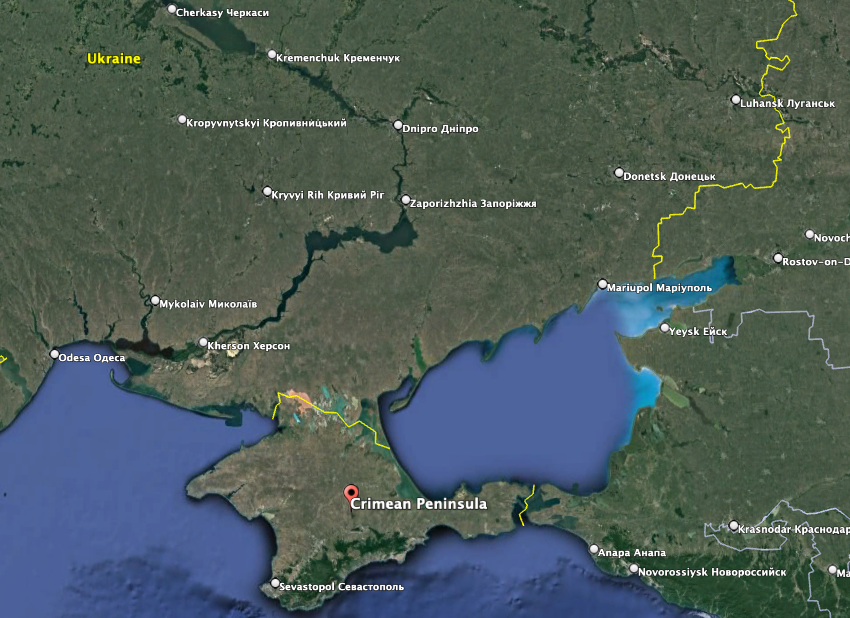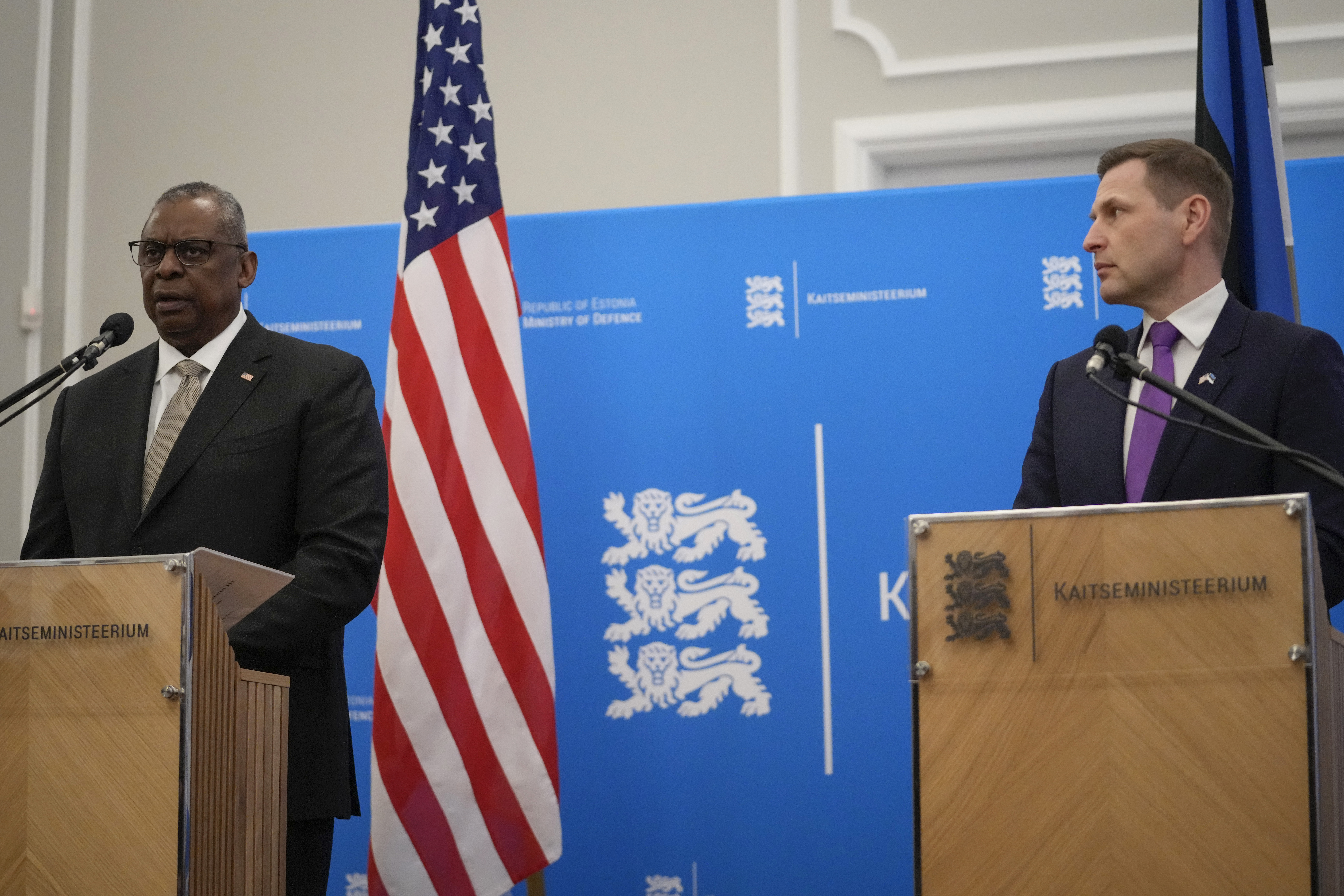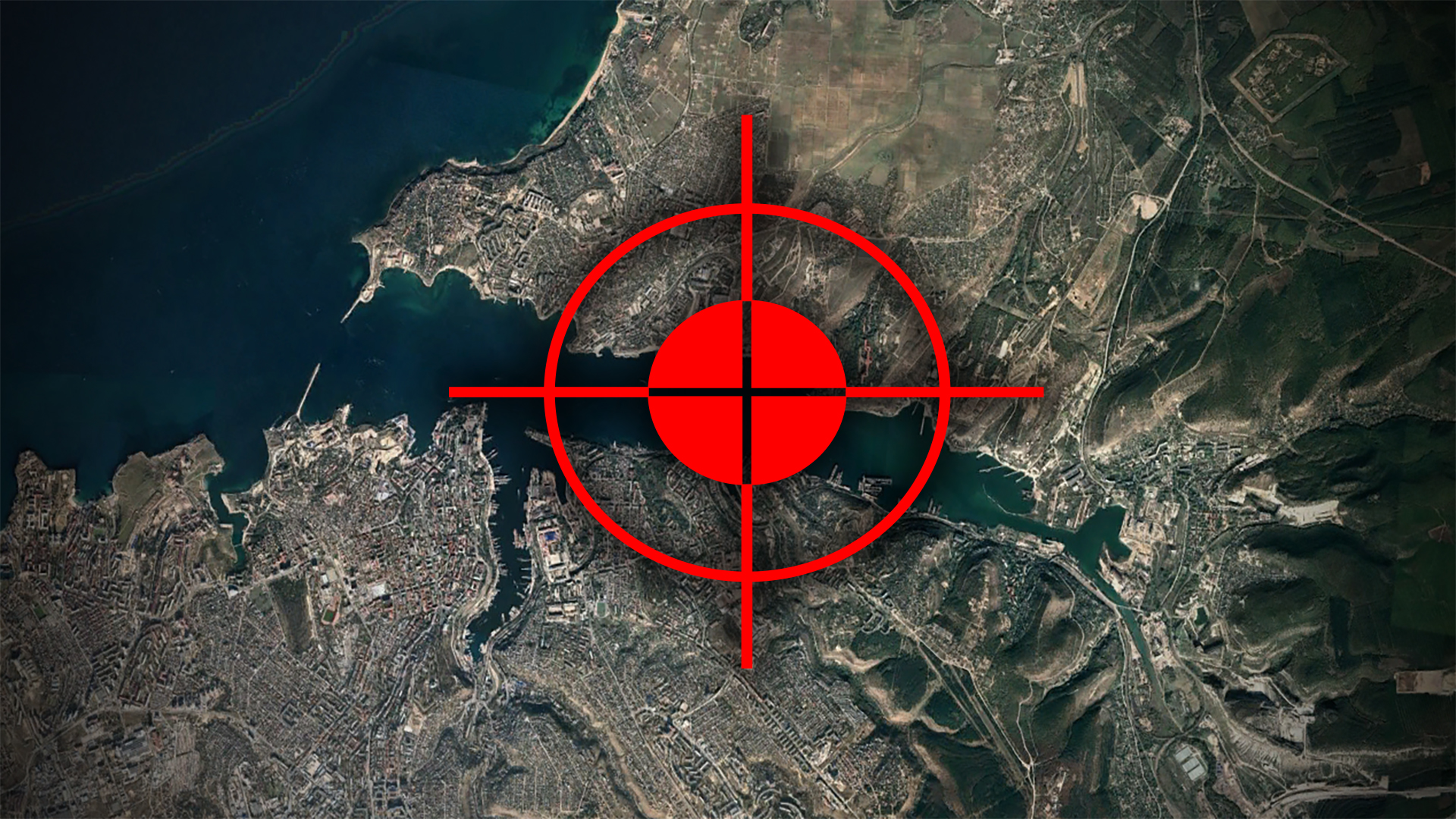Though the bulk of the fighting in Ukraine is taking place in the Donbas, especially in and around Bakhmut, Kyiv has not taken its eye off Crimea. That point was apparently hammered home over the skies near Sevastopol overnight Wednesday and into Thursday.
“Beginning at night, the attack on the peninsula began,” Sevastopol occupation governor Mikhail Razvozhayev announced on his Telegram channel Thursday.
The Black Sea Fleet and local air defenses shot down two Ukrainian drones “in the zone of Sevastopol,” Razvozhayev wrote. “Several more UAVs were shot down in the water area – in the zone of the Republic of Crimea. Everything is calm in the city. Trust only official information.”
While “everything was calm,” ferry service was apparently halted during the attack.
Meanwhile, video and images began appearing on social media of a huge cloud apparently resulting from an explosion about 100 miles to the north near a Russian military base in Armyansk, a town on the northern tip of the Crimean peninsula.
It’s unclear at the moment what happened, but the local Ukrainian CrimeanWind Telegram channel said Russian officials provided several explanations, ranging from it being “a cloud of unusual shape” to ongoing training to the disposal of World War II ammunition.
Whatever the reason, Crimea has, as we have written about many times before, been a frequent target of Ukrainian drone attacks.
Last month, Razvozhayev reported on his Telegram channel that two drones were intercepted and shot down over the Black Sea on Jan. 2. Russian air defenses were also activated that day over Dzhankoy, home to a Russian airbase.
There were two reports of air defenses at Sevastopol being activated in December, including another case of Ukrainian drones being shot down, according to Razvozhayev at the time.
And in August, a mysterious, ‘available on Alibaba,’ converted long-range suicide drone attacked the Black Sea Fleet headquarters in Sevastopol. These drones are likely the same weapons that have repeatedly made attacks on the Black Sea stronghold since.
It all started on July 31, when a mysterious drone attacked Sevastopol. It appears the drone impacted a roofline, damaging it, but there is no word on casualties, at least according to Russian officials. At the time, we predicted that this was just a sign of what was to come, which proved all too accurate.
Ukraine has also used explosive-laden unmanned boats in offensive operations, including in a large-scale October attack on Sevastopol, home of the Russian Black Sea Fleet. Russian sources claimed Ukraine used them again a few weeks later in Sheskharis Harbor in Russia’s Black Sea port of Novorossiysk.

The most recent drone attack on Sevastopol came hours after Secretary of State Antony Blinken told a group of experts via a Zoom call that a “Ukrainian attempt to retake Crimea would be a red line for Vladimir Putin that could lead to a wider Russian response,” according to Politico.
“According to four people with knowledge of Blinken’s response, he conveyed that the U.S. isn’t actively encouraging Ukraine to retake Crimea, but that the decision is Kyiv’s alone. The administration’s main focus is helping Ukraine advance where the fight is, mainly in the east.”
But despite that advice, Ukraine is eyeing an effort to recapture Crimea, which Russia invaded in 2014, a goal repeatedly espoused by President Volodymyr Zelensky and others.
In October, Ukrainian Maj. Gen. Kyrylo Budanov, head of that nation’s Defense Intelligence directorate (GUR), told The War Zone that Ukraine would recapture the peninsula sometime this year.
While Blinken reportedly suggested that Ukraine focus on the Donbas, the liberation of Crimea would achieve two goals, Ben Hodges, a retired Army lieutenant general who commanded U.S. Army Europe, told The War Zone on Thursday.
“Crimea is the key,” he said. “it is the decisive terrain.”
Ukraine should “focus on Crimea now as the main effort while using ‘economy of force’ in the east to slow/stop Russian ground attacks.”
With its Black Sea Fleet and several other Russian military installations on Crimea, “Ukraine knows they’ll never be safe or secure so long as Russia occupies” the peninsula.
“Any ‘peace settlement’ which results in Russia holding on to Crimea only means that Russia will wait two or three years until we, the West, will lose interest and … meanwhile, they’ll rebuild their military, address their mistakes, and restart their war against Ukraine. That’s been the pattern since 2008.”
In addition, “Kyiv also knows that they’ll never be able to rebuild their economy so long as Russia occupies Crimea. No access to the Azov Sea means that Mariupol and Berdiyansk can never function again as seaports, even after they’re liberated. The Black Sea Fleet would continue to disrupt/interdict commerce in and out of Odesa. And Russian claims to territorial waters, if not challenged, would deprive Ukraine access to potential gas deposits under the Black Sea. So Ukraine has to liberate Crimea. It is the key. Do that first, this year. Donbas will come later. It’s important but not decisive.”

The sentiment about Donbas’ role in Ukraine’s ultimate goals echoes what White House National Security Council spokesman John Kirby told reporters on Feb. 14 about Bakhmut, the coal-mining city in Donetsk Oblast that is at the heart of the fighting in Donbas right now.
“As we have said before, I think we shall say again today, even if Bakhmut falls it would not have the strategic impact on the overall war,” said Kirby. “I would go so far as to say it won’t even have necessarily a strategic impact.”
To liberate Crimea, Ukraine will need to make it “untenable for the Russian Army, Navy and Air Forces on the peninsula and then occupying it.”
That means starting with “isolating it with long-range precision strike against the only two land lines of communication that connect it to Russia – the Kerch Bridge, already severely damaged [in an Oct. 8 attack] – and the so-called ‘land bridge’ which connects Crimea to Russia via Mariupol and Melitopol along the coastline of [the] Azov Sea. Targeting that transportation infrastructure will begin the isolation of Crimea from resupply or movement.”
A “large Ukrainian armored force that attacks southeast in the direction of [the] Azov Sea and penetrates Russian linear defenses would complete the isolation of Crimea and enable the closer deployment of [M142 High Mobility Artillery Rocket Systems, or] HIMARS launchers which could then be in range of specific Russian facilities on Crimea.”
The peninsula, he added, “is about the size of Massachusetts. There’s no place to hide. All Russian facility locations are well known and obvious – and vulnerable.”
“Precision strikes on Sevastopol will force the Black Sea Fleet to reposition to Novorossisk which is far less capable as a base, and further away from Ukrainian cities. The airbase Saki, on the west coast of Crimea, should become completely unusable. And the logistics hub at Dzankoy in the north of Crimea should become a huge bonfire.”
Both of those facilities have either already come under attack before, as in the case of Saki Air Base, which we wrote about here, or had air defenses activated for reasons still unclear, as we previously mentioned.
“Once Crimea is untenable, then [Ukrainian] ground forces can begin to attack south, towards the Perekop Isthmus, and then into broader Crimea,” said Hodges. “Other Ukrainian assets ([Special Operations Forces], marines, unmanned systems, etc) will also play a role.”
Whether Ukraine tries to accomplish what Budanov told us it would, or adheres to Blinken’s apparently more cautious approach remains to be seen. But either way, it is something we will watch closely.
Before we head into the latest news from Ukraine, The War Zone readers can get caught up with our previous rolling coverage here.
The Latest
During a press conference in Estonia, U.S. Defense Secretary Lloyd Austin once again hinted at a future Ukrainian offensive without offering any specifics about where or when and talked about the current Russian offensive in the east.
Asked about whether the billions of dollars of tanks, infantry fighting vehicles and other equipment promised to Ukraine by the U.S. and allies will arrive in time to make a difference, Austin called it a “work in progress.”
“We’ve really laid out a detailed plan on how we’re going to bring things in support of Ukraine and provide them that gear,” he said. “So this is a work in progress, but it’s something that our leaders are working on very, very diligently. And again, Ukraine – it’s Ukraine’s fight. We’re going to provide them all the support that we can possibly provide them so that they can have the best chance of being successful in the upcoming offensive.”
“In terms of whether or not Russia has started its offensive, what we’re seeing – as you’ve heard me say before – is Russia continued to introduce a large number of troops into the theater,” U.S. Defense Secretary Lloyd Austin told reporters Thursday at a joint press conference with Estonian Defense Minister Hanno Pevkur. “Those troops are ill-equipped and Ill trained and because of that they’re incurring a lot of casualties and we expect that that will continue.”
“We’ve also seen them increase their artillery fires in the Bakhmut area, and Bakhmut’s been a contested area for some time. We expect to see that continue, as well.”

The Institute for the Study of War (ISW), for one, discounts the extent of that offensive.
“Russia’s costly military campaign in Ukraine has likely significantly depleted Russian equipment and manpower reserves necessary to sustain a successful large-scale offensive in eastern Ukraine,” ISW said in its latest assessment. “Russia’s inability to reconstruct spent mechanized material in the short term further restricts the Russian military’s mechanized maneuver warfare capabilities.”
Here are some other key takeaways from that assessment:
- Russian forces continued offensive operations northwest of Svatove and along the Svatove-Kreminna line.
- Russian forces continued offensive operations around Bakhmut, along the western outskirts of Donetsk City, and in western Donetsk Oblast.
- Russian sources implied that Ukrainian forces may hold positions on the east (left) bank of the Dnipro River in Kherson Oblast, although ISW has not observed any confirmation of the claim.
- The Kremlin continues to fund its war efforts in Ukraine from regional budgets.
- The Russian government continues to further integrate occupied territories into Russian governance structures.
Bakhmut, meanwhile, continues to be held by Ukrainian forces, including the Sheikh Mansur Battalion, seen here talking about the ongoing defense of that embattled city in Donetsk Oblast.
The fight for Bakhmut isn’t just taking a toll on combatants and civilians. Livestock is also suffering, as in the case of this cow apparently killed by a Ukrainian drone strike.
The Russians also continue to have a tough time in Avdiivka in Donetsk Oblast, where they reportedly lost two BMP-2 infantry fighting vehicles, one destroyed, the other captured.
Yesterday we told you about how Ukraine combined ramping up fuel imports with using thousands of tanker trucks as a mobile storage system to reach a surplus of fuel.
The latest Russian missile barrage, which hit a fixed fuel storage facility late Wednesday night, served to highlight the importance of having so many dynamic targets that the Russians are not equipped to strike.
That strike also apparently highlighted something else we wrote about yesterday, how Russia is working to overwhelm and confuse Ukrainian air defenses (albeit with balloons yesterday).
Russia attacked Ukraine with drones and missiles in the north and west as well as in the Dnipropetrovsk and Kirovohrad regions, according to the official Ukrainian UNITED24 media outlet’s Telegram channel, citing Andriy Yermak, head of the office of President Volodymyr Zelensky.
“The Russians have somewhat changed their tactics,” Yermak said. “They conduct active reconnaissance, use false targets. But the air defense managed to deal with most of the enemy’s missiles and UAVs.”
Though it was kicked out of Kharkiv Oblast in the fall, Russia continues to launch attacks against Ukrainian targets there, as it did Thursday, killing one and injuring six others.
In an interview with the BBC, Ukrainian Secretary of the National Security and Defense Council, Oleksiy Danilov said he believes that after the failure of the plan to completely take over Ukraine, Russia moved to an alternative option and wants to divide Ukraine according to the principle of North and South Korea.
He also said he believes that the Russians aim to capture Bakhmut by February 24.
Israel has come under heavy criticism for not doing more to help Ukraine.
Thursday, the new Israeli Foreign Minister Eli Cohen made the first trip of any Israeli government official to Ukraine since the start of Russia’s all-out invasion. He came to visit Zelensky and Ukrainian Foreign Minister Dmytro Kuleba.
After the meetings, Zelensky thanked Cohen for the visit even though it did not appear that any military aid was forthcoming, something that the new Netanyahu government has been reluctant to provide.
“Israel has always been our important partner in the Middle East,” Zelensky said in a message posted on his Telegram channel Thursday. “This is the first visit of an Israeli representative since the beginning of the full-scale invasion.”
“During a meeting with Foreign Minister Eli Cohen we discussed deepening bilateral cooperation in various areas. I invite Israel to join the implementation of our Peace Formula.”
“I am grateful for the humanitarian aid provided. We discussed the country’s participation in post-war reconstruction. Ukraine could use Israel’s experience in demining.”
“I hope that this visit will contribute to deepening our cooperation.”

On Tuesday, the Conflict Observatory released a report accusing Russia’s federal government of “operating a systematic network of camps and other facilities that facilitate the re-education and adoption of children from Ukraine.”
These facilities in Russia and Russia-occupied Crimea “have held at least 6,000 children from Ukraine since Russia’s full-scale invasion on 24 February 2022. The Yale School of Public Health’s Humanitarian Research Lab (HRL) has identified dozens of camps and facilities and many of the key figures coordinating these efforts.”
On Thursday, Russia’s children’s rights commissioner Maria Lvova-Belova, who is prominently featured in that report as a ring-leader, told Putin she “adopted” a teenager from Mariupol.
“Now I know what it means to be a mother of a child from Donbas. It’s hard, but we definitely love each other. I think we can handle anything,” Maria Lvova-Belova said on Thursday, according to The Moscow Times, in response to a question Putin asked her during a meeting at his Novo-Ogaryovo residence near Moscow.
Check out how the Ukrainian “Angry Birds” drone unit attacks Russian troops.

As explained above, drone-dropped munitions are now a ubiquitous part of this war, as these Russian troops found out the hard way.
The Russians too are using drones to launch grenades and other munitions, only this drone got taken down before it could unload. In this case, it was carrying an OF-62 76mm high explosive frag projectile usually fired from AK-176 or AK-726 naval guns.
This is a unique hybrid VTOL drone blending the capabilities of a quadcopter and a fixed-wing drone. You can read more about the concept here.
Russians are also using Lancet loitering munitions, but those don’t always destroy their targets, as you can see in this compilation of videos posted by @RALee – senior fellow at the Foreign Policy Research Center.
Still, Russian milbloggers are complaining that Russian troops don’t have enough Lancet drones to go around.
If you’re reading this story, you probably love helicopters and want to see them fly combat missions.
So check out this video, shot from the gunner’s cockpit of a Ukrainian Mi-24 Hind attack helicopter.
There was another prisoner exchange Thursday, with 100 troops and one civilian returning to Ukraine from captivity.
And finally, take that Putin!
The European Union has banned the sale of toilets to Russia as punishment for its full-on invasion of Ukraine, according to The Telegraph.
In its 10th package of sanctions, the EU will also ban other bathroom items, according to the Telegram channel of the Ukrainian UNITED24 media outlet.
“Many industrial goods are on the list of restrictions,” according to UNITED24. “This includes ‘bidets, wash basins, cisterns, and similar plumbing fixtures as well as LEDs, hemp yarn, forklifts, mail sorters, chimneys, bricks, tires, and even ‘pens and pen tips.’”
That’s it for now. We’ll update this story when there’s more news to share.
Contact the author: howard@thewarzone.com
